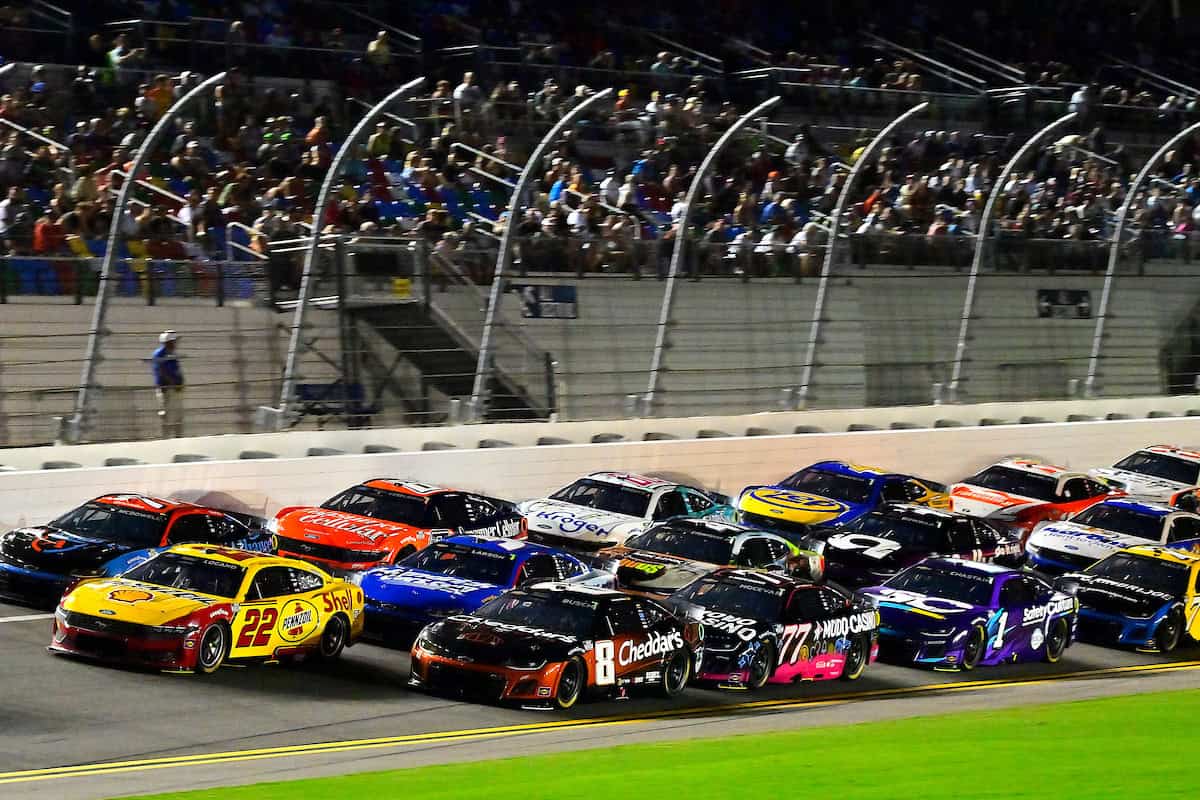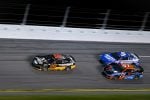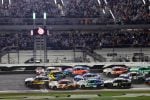What Happened?
DAYTONA BEACH, Fla. – Ryan Blaney upset the upsets by going from 13th to the lead in two laps to win at Daytona International Speedway on Saturday night, Aug. 23. Daniel Suarez, Justin Haley, Cole Custer and Erik Jones all narrowly missed out on a sudden playoff berthing win by finishing behind him in the top five.
Tyler Reddick and Alex Bowman both secured the final two positions of the NASCAR Cup Series playoffs.
This is Blaney’s second Cup Series win of the season, and he becomes the first repeat winner of the summer Daytona race since Tony Stewart in 2012.
What Really Happened?
Two good races in a row? It’s about time we had some positivity around here.
If you had asked anyone in the media center how late Saturday night’s 400-miler was going to end, many of them would non-jokingly said Sunday morning.
That’s been the nature of superspeedways and drafting tracks as of late, especially with the Next Gen car. The constant pattern of three-to-four-wide packs are a wonderful look for photographers and fans at the racetracks themselves. However, the constant need to save fuel makes the racing not as intriguing to follow when you know drivers aren’t four-abreast with their feet to the floor constantly looking for any advantage to gain position.
To make matters worse, it usually culminates in half of the field going home with destroyed race cars and pissed off drivers and team owners. For an example, see Friday night’s NASCAR Xfinity Series race.
We were expecting more of the same on Saturday, playoff drama or no.
But for some odd reason, that didn’t happen.
Instead, what we got were real three-wide (and sometimes four) battles for position with drivers that were legitimately trying to gain positions through the field.
And it was (mostly) occurring the whole race. After three wrecks brought out three separate cautions in stage one alone, I believed we were going to see a single-file train for the final 100 laps until three laps to go.
But it was more battles for the lead and underdog teams making the most out the opportunity the great equalizer of Daytona provides. There were some incidents sure, but nowhere near on the level as what we saw at the Daytona 500 – a race that had 13 DNFs and an overtime restart.
To top it off, it culminated in a wild eight-lap green flag run to the finish that had six lead changes between four drivers in must-win situations, a four-wide finish that broke the record for closest top-four in NASCAR history and, above everything else, no crashes.
Maybe it was the way the stage breaks were spread out. Maybe it was the cautions falling at just the right time that allowed teams to pit. Maybe it was the big crash that took out some of the field early on that narrowed the chance of more big ones to occur later.
Regardless, the result is what it is: the best damn Next Gen race at a superspeedway we’ve seen thus far, and for a while, I was wondering if that was even possible.
Who Stood Out?
In a few years, we may look back at Blaney’s run to the lead as something of legend.
In only two laps, the No. 12 Team Penske Ford rocketed from 13th position all the way to the lead with less than half a lap to go to win on Saturday night.
Yet oddly enough before that, he hadn’t seen the top spot of the race since stage one where he led 26 other laps after starting from the pole he earned when rain canceled the weekend’s qualifying session. Even more odd, after leading only 27 laps throughout the night, he still actually tied for the race high amount with teammate Joey Logano – the least amount for a race high at Daytona since summer 2011.
Both Penske teammates had their moments in the limelight during the night. For Logano, however, it occurred mostly in the final stage with less than 50 laps to go. The moment that bright yellow No. 22 cleared for the lead the first time Saturday night, everyone who’s been watching long enough knew he was going to be the one to beat.
And for the most part, he was. That is, he was until 12 laps to go when he received a bad push from Erik Jones that sent him spinning to the inside.
Logano finished 27th, one lap down after he got stuck in the grass, but there was no doubt he would’ve been an unsurprisingly tough car to get by in the closing laps had he not spun.
Who was surprisingly tough to get by for 23 whole laps was Cody Ware.
Yes, you read that right.
In nine whole years of Cup Series competition and 167 combined starts across NASCAR’s top three divisions, Ware has not once led more than four laps in a single race in his entire career.
On Saturday, he led 23.
It wasn’t some silly fluke, either. Ware inherited the lead on lap 39 after the end of the first stage from pit strategy. Then, he just kept it. It wasn’t from a single file period where nobody was passing anyone, either. Ware was blocking lanes and protecting from runs for the lead, at some points side-by-side with the person in second. For 23 laps, the NASCAR world was picturing what a universe with a Rick Ware Racing Cup car in victory lane would look like. It was tough to imagine.
Yet there he was, and while his last lap led was on 78, just short of the halfway mark, Ware made a career statement on Saturday that put more eyes on him than maybe he ever has while on track.
Who Fell Flat?
You could have thrown a blanket over the top seven cars as they reached the start finish line.
For five of them, it was the end of their playoff hopes.
In the final eight laps, however, they all kept the crowd – and the playoff cut driver Bowman – guessing as to who was going to win their way into the postseason. Because for eight laps, they all had a grasp at the lead.
Jones, who restarted as the leader at the beginning of the eight-lap shootout, got knocked out of the way with only six to go. Then it was Ryan Preece, who was side-by-side with Justin Haley for the lead, who was being pushed by Chris Buescher, who was being pushed by Ty Gibbs. Then Cole Custer took the lead with one lap to go and, well, you get the idea.
For Bowman and his fans, hope really seemed all but lost, as a majority of the top 10 cars consisted of drivers in must-win scenarios. So, when Blaney received one big push from Daniel Suarez on the outside lane on the last lap on the backstretch to take the lead, it must have been incredibly alleviating.
After 26 races, six drivers were within only a couple of laps of saving their entire seasons only to fall just a few feet short.
Paint Scheme of the Race
It’s so rare nowadays to see Coca-Cola come on board a Cup Series car as a primary sponsor even if it’s only for one race.
But when they do, they really put on a great design.
Suarez’s livery for this weekend’s Coke Zero Sugar 400 was no different.
The bright red and white Hecho en Mexico scheme design is a decent appeal to the eyes alone, but pairing it with the reflective number font on a night race made it all the nicer to look at.
Not to mention, we should enjoy the Coca-Cola schemes while we can seeing as how the No. 99 will likely have Red Bull as a beverage sponsor in 2026.
What’s Next?
The playoffs can finally begin and in crown jewel fashion no less.
The Cup Series returns to Darlington Raceway for the first round of this year’s postseason. Coverage for the Southern 500 crown jewel race will be live on USA Network on Sunday, Aug. 31 at 6 p.m. ET.
Dalton Hopkins began writing for Frontstretch in April 2021. Currently, he is the lead writer for the weekly Thinkin' Out Loud column, co-host of the Frontstretch Happy Hour podcast, and one of our lead reporters. Beforehand, he wrote for IMSA shortly after graduating from Embry-Riddle Aeronautical University in 2019. Simultaneously, he also serves as a Captain in the US Army.
Follow Dalton on Twitter @PitLaneCPT






